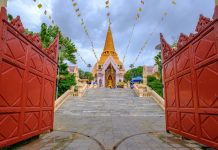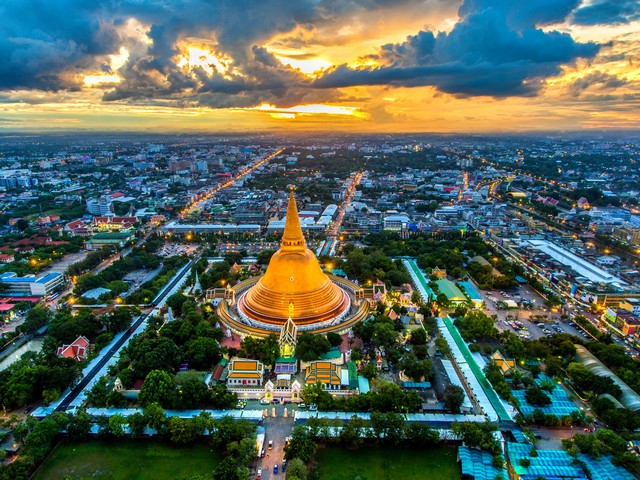
Wat Phra Pathom Chedi Ratcha Wora Maha Wihan
One of the most famous Chedi (pagoda) in “Phra Pathom Chedi” which considered the most massive pagoda in Thailand. The appealing stupa nestles in Wat Phra Pathom Chedi Ratcha Wara Maha Wihan in Nakhon Pathom which is classified as one of six the highest grade of the first-class royal temple. The temple is rich in its historical value that lasts long over the centuries in the ancient region of Suvarnabhumi (the Golden Land). The temple is essential landmark mainly as a house of the Buddha’s relic together the symbol of Nakhon Pathom province.
Todays, the existing primary stupa is Ceylonese pagoda with Sukhothai style that constructed during the reign of King Mongkut (Rama 4). The pagoda overarches two old pagodas which are Sanchi Stupa built followed to the stupa in India during the period of King Ashoka the Great and the ancient Khmer pagoda. Further, in the south of Phra Pathommachedi and Ubosot (ordination hall) is the location where the white stone Buddha statue enshrined. The figure is one of four Buddha statues in the attitude of sitting to deliver the sermon that cast in Dhavaravati.
History of Phra Pathom Chedi
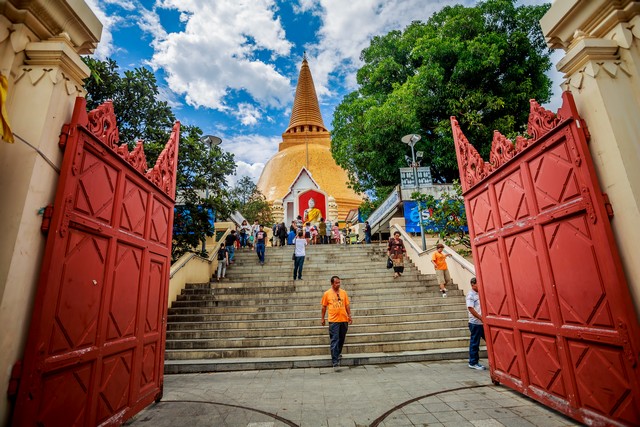
Phra Pathom Chedi or Phra Pathommachedi is an enormous stupa situates in Wat Phra Pathom Chedi, Nakhon Pathom about 60 km from Bangkok. It considered as one of the oldest sacred places in Thailand. There is the belief that it founded during the glorious time of Ashoka the Great who sent out the missionary Sanghas to distribute the Buddhism sermon. Many archaeologists agreed that Sona Thera and Uttara Thera one the Sankha team who had been sent over to Suvarnabhumi visit Nakhon Pathom as the first location in about the 3rd BE. And they established the Sanchi style hemispherical stupa over there.
During King Rama 4
When King Rama 4 ordained as the Buddhist priest, he took an occasion to pay homage at the monastery compound. He spotted the pagoda with the prang shaped top with 84 meters high. And once he succeeded to the throne 1853, then he bestowed to construct a new stupa with 120 meters and 45 cm in its height to cover up the original one including to the cloister and balcony. Unfortunately, the king passed away before the work finish.
Regards to the top of the pagoda of which in the Khmer top style, the King Mongkut contemplated that it might have some member of the royal family ordered to repair. That idea is identical to the 2nd inscription (Wat Srichum’s Inscription) noted by the Buddhist monk Phra Maha Thera Si Sattha. It described that he came by to renovate the pagoda which initially called “Thom Chedi” before the went to Rad town which was the same journey back from the study the Buddhist doctrines in Sri Lanka. So that, King Rama renamed the stupa as “Phra Pathommachedi”.
Notwithstanding, some historians and archaeologists identified that Phra Pathommachedi is not the oldest stupa of Suvarnabhumi but instead Phra Maha That Luang in Dhavaravati. There are many supported reasons for this notably the discovery of a stupa which is older than the Thom Chedi, and the written evidence noted that Phra Pathommachedi of which the Khmer used to call as “Phra Thom”. The word “Thom” in Khmer means large that identical to local vocabulary is “Luang”. And Thais call Angor Thom in the name “Phra Nakhon Luang” from the same aspect.
During King Rama 5-7
Later, King Rama 5 gave the command to repair the stupa and build a bell tower and tiling until all work done. And King Rama 6 ordered to renovate the Royal Chapel and made the painting of previous pagoda and other murals on the wall. More than that, he commanded to dismantle the north veranda and rebuilt to house the Buddha statue called Phra Ruang Rojanarit Sri Indraditya Dhammobhas Mahavajiravudhraj Pujaneeya Bophitr. And then, King Rama 7 bestowed to construct a new ordination hall.
Phra Pathommachedi is where to enshrine the Gotama Buddha’s relic which is praised among the Buddhist worldwide. The monastery schedules the celebration to worship the insignificant stupa on the 12th waxing moon to the 5th waning moon of the 12th lunar month in total is 9 days and 9 nights annually.
Furthermore, Wat Phra Pathom Chedi is also the house to store the ashes of King Rama 6, HRH Suvadhana, Princess Consort of King Rama 6, and his daughter Princess Bejaratana Rajasuda. Those are saved inside the wall behind Phra Ruang Rojanarit statue at the north chapel of the grand stupa.
About the stupa of Wat Phra Pathom Chedi

Phra Pathommachedi is a massive bell-shaped stupa with timber structure and fastened with the large chain, laid the brick and concrete and finished with tiles. The stupa consists of the chapels in all 4 directions and 2 layers of the defensive wall.
Fact about the stupa
- Height from the ground to the top is 120.45 meters
- The circumference of the base is 235.50 meters
- Diameter is 56.64 meters
- From the bottom to the square is 18.30 meters
- The square is 28.10 meters each side
- 27 tiers of the top part
- 16 pillars
- The surrounding balcony is 562 in its length
- The inner defensive wall is 912 in its length
- 24 bell arches
Highlights of Wat Phra Pathom Chedi
1. Phra Ruang Rojanarit
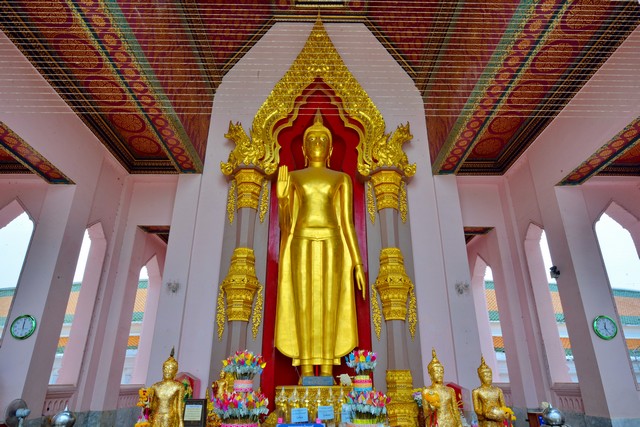
It is a standing Buddha statue in
the attitude of forgiveness enshrined in the arched space to the north upfront
of the stupa. The image was cast in Rama 6 by collecting the head, hands, and
feet parts from Sri Satchanalai,
Sukhothai.
While King Rama 6 presided the crown prince, he took the trip to inspect the historical remains in the northern territory in 1909 and discovered a ruined Buddha image was buried in the ground of the old monastery at Sri Satchanalai. He ordered to till and found the head, hands, and feet parts of the Buddha image that are completely fine. Hence, he requested to invited all parts to Bangkok. And once he succeeded to the throne, he assigned Prince Narisara Nuwattiwong cast the wax model of whole Buddha statue including the royal ceremony to smelt at Wat Pho in 1913.
The importance of the buddha
The finished Buddha image is a standing statue in the attitude of persuading the relatives not to quarrel. And the figure housed in the archway at the top of the central stairway on November 2, 1915, and named as “Phra Ruang Rojanarit Sri Indraditya Dhammobhas Mahavajiravudhraj Pujaneeya Bophitr” with the height from top to bottom is about 6.10 meters. Apart from that, King Rama 6 noted in the royal testament to store his ashes under the Buddha’s image pedestal.
Phra Ruang Rojanarit Sri Indraditya Dhammobhas Mahavajiravudhraj Pujaneeya Bophitr is an official name of the statue according to the royal command proclaimed on October 12, 1923. However, the icon renowned in local as Luang Pho Pra Ruang or Phra Ruang Rojanarit. And the image is one of the essential holy objects that Buddhist in Thailand praise.
After King Rama 6 passed away, his ashes were invited to store under the pedestal of the Buddha’s image followed to his will. The royal ceremony to store the king’s ashes took place at the Phra Patommachedi on August 31, 1926. After the royal cremation of HRH Suvadhana, Princess Consort of King Rama 6, King Bhumibhol the Great (Rama 9) bestowed to invited the ashes to store next to King Rama 6’s ashes on March 17, 1986. And on December 12, 2012, the ashes of Princess Bejaratana Rajasuda a daughter of King Rama 6 was buried next to her parent.
2. Viharn Panjavakki (The Chapel of the Five Ascetics)
The chapel locates at the upper level of the central stupa. The interior of the chapel contains the delicate and aesthetic mural paintings about the Buddhism history, construction background of the stupa, and the 3 periods of the stupa in Rattanakosin era. And as on the information from the carer of the monastery said that the chapel just finished the restoration recently that why the color of the mural is still colorful and gorgeous.
3. The Buddha image in various attitudes
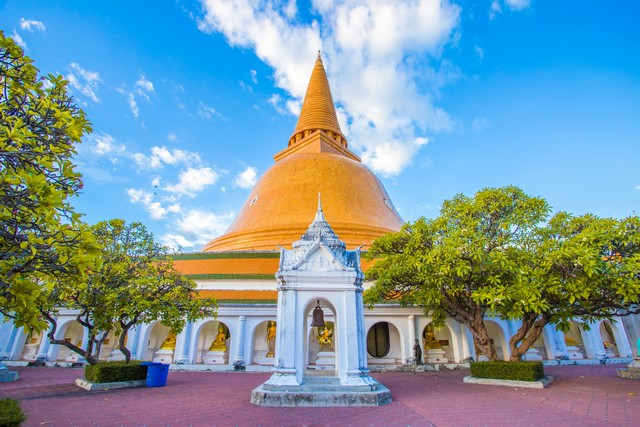
From Viharn Panjavakki, there is the location to enshrine an array of the Buddha images in different positions. Luckily, the monastery installed the description plate of the Buddha images with English translation. So, any visitors can understand the figures.
4. The model of the old stupa
The temple created the model of the original stupa located in the compound. Even though it is just the model but it is not lesser in its beauty to the existing one at all.
5. Thum Lub Lae (Legendary Cave) and Thum Takien Thong (Gold Hopea odorata Cave)
Lub Lae Cave is quite narrow at the entrance and needs to be careful to walk into the cave. The cave is to house the Bodhisattva Guan In, Luang Pho Phan Pee (Thousand years Buddha), and Phra Sankhagajaya (the smiling Buddha). And Takien Thong Cave, on the other hand, has the more extensive walkway, where the location to house Somdet Phra Buddhacarya (To Brahmaramsi) and Chao Mae Takien Thong (female guardian spirit) statue.
Since Nakhon Pathom is one of the ancient historical sites in Thailand, so plenty of researchers and site surveys discovered a lot of antiques in Ban Chiang and Dhavaravati – Buddha images, crushed stone, bracelets, antique currency, clay beads, etc. Those archaeological finds are collected and appropriately stored at “Wat Phra Pathom Chedi Museum” where locates in the east opposite from the ordination hall. Apart from the collections of antique, the museum stores a coffin of “Jarlet,” King Rama 6’s favorite royal dog, as well.
6. Chao Pho Prasart Thong Shrine and the White Stone Buddha statue
Taking the trip to Wat Phra Pathommachedi, the visitors should not miss paying homage to Chao Pho Prasart Thong Shrine and the White Stone Buddha statue. And it is popular among the Buddhist visitors to walk 3 rounds in clockwise surrounding the main stupa whether external or internal veranda to pay respect and make a wish for luck and prosperity.
Furthermore, in the evening there is a flea market outside of the monastery complex. The market features an array of delicious food for example egg noodle with wonton, crispy noodle in stick gravy, Pad Thai, Mussel omelette, Pork noodle, Beef noodle, a la carte, kinds of seafood. And many menus of yummy dessert – Chaozhou dumpling, Thai coconut pudding, and flying ice-cream, etc.
Information of Wat Phra Pathom Chedi
Operating time: 7.00am – 8.00pm
Tourist season: all year round
Admission fee: Free of admission fee for Thai / THB40 for Foreigners
How to Get to Wat Phra Pathom Chedi
By Car:
From Bangkok, drives on the old route (Petchakasem Road) the highway number 4, passes Om Noi, Om Yai, Sam Prarn until arriving at Nakhon Pathom.
Or drives on the new route from Bangkok and head towards to Boromarajonani Road. Drives pass Phuttamonthon, Nakhon Chaisi until reaching Nakhon Pathom. Notice the direction signage to Phra Pathommachedi.
By Bus:
There are many bus services route Bangkok – Nakhon Pathom depart from the Southern Bus Terminal daily from 5.30am to 11.15pm. For more information call 1490 or website www.transport.co.th
Moreover, there are van service route Bangkok – Nakhon Pathom departs from the Southern Bus Terminal (Pinklao). And drop off at the temple.
By Train:
State Railway of Thailand provides many trips to Nakhon Pathom per day. The journey starts in Bangkok at Bangkok Noi Railway Station and gets off and Nakhon Pathom Station with the duration of an hour. For more information can call 1690 (24 hours every day) or www.railway.co.th


